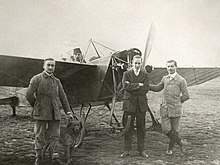//Ed. note: Ottoman Capt. Siyami, who had
received training in Prussia, had a book
about airplane use, written by a Prussian
army lieutenant, translated into Turkish as
a contribution to the Beyoğlu Donanma
Cemiyeti campaign for an Ottoman airplane
fleet.
Ottoman AF History click here for a very
good Wikipedia page on this subject.
Capt. Siyami's note in this regard://
The few bombs that airplanes drop currently do not make for
a decided
advantage militarily. The
nations in the forefront of aviation are
Germany and France. We hope that these nations will continue with
their efforts to increase the military effectiveness of this apparatus. We
think that our hopes in this regard are
justified and we must not distance
ourselves from the airplane and its related
organization.
Lately, we have translated the book written by First
Lieutenant Walter
Macinto, an airplane instructor in the Prussian Army. We would like to
present this book, in Turkish,
to the Beyoğlu Donanma Cemiyeti as a
small token of our debt vis-a-vis
contributions regarding an Ottoman
airplane fleet.
((signed)) First
Lieutenant Siyami of the (Ottoman Army) Artillery,
who received training in the
Prussian Army.

Ottoman pilots in 1912.
Author’s (Prussian First Lt. Macinto) foreward in his book:
Airplanes provide great advantages to armies for
reconnaissance and
warfare. Although the means airplanes use in these
activities are
otherwise available, their use in airplanes cannot be
duplicated elsewhere.
Airplanes’ biggest advantage is speed – 80 to
100 kilometers per hour,
which is faster than our fastest trains. An airplane pilot can tell his
commander
that an enemy is approaching a day’s march away, within
20 to 30 minutes. The obstacles that face a cavalry, such as
enemy
chain lines, vanguard squads,
rivers and valleys present no difficulties
for airplanes. The only thing that restricts airplane reconnaissaince is
foul weather, in terms of fog, clouds, dust, smoke, rain and snow.
However, as airplane use develops and progresses, weather conditions
for flying will be better understood. The restrictions they pose have
made airplane flight dangerous thus far, in light of limited familiarity,
haste and boldness.
//Ed. note: to underscore the human
cost imposed by these early avaiation
efforts, Capt. Siyami included this
table of lives lost in various nations
over the years, from a German
military aviation newspaper.
The nations listed on the right are,
from top to bottom: Germany (18),
France (41), America (23), Russia (6),
Italy (7), Belgium (3), England (7),
Austria (3), Switzerland (2),
Spain (1), Serbia (1), Montenegro (!).
(Total lives lost in parentheses).
The years across the top are, from
right to left:
1897, 1899, 1908, 1909, 1910,
1911 and the two columns under
each year are for pilot and
'machinist' deaths.
//The heading reads: Sacrifice
for Aviation: the toll for each
nation".//


Hiç yorum yok:
Yorum Gönder